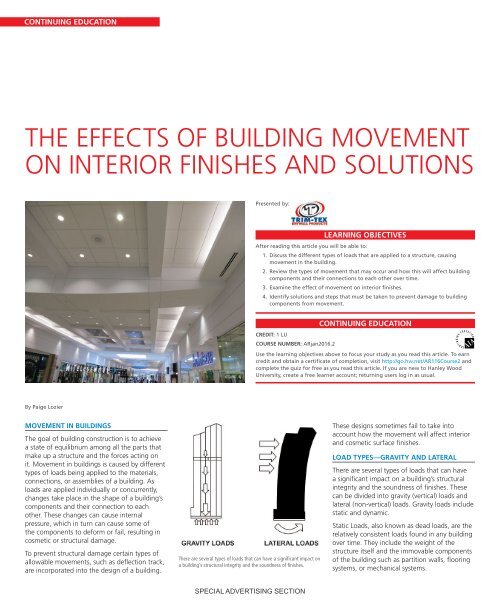Architect 2016-01
You also want an ePaper? Increase the reach of your titles
YUMPU automatically turns print PDFs into web optimized ePapers that Google loves.
CONTINUING EDUCATION<br />
THE EFFECTS OF BUILDING MOVEMENT<br />
ON INTERIOR FINISHES AND SOLUTIONS<br />
Presented by:<br />
LEARNING OBJECTIVES<br />
After reading this article you will be able to:<br />
1. Discuss the different types of loads that are applied to a structure, causing<br />
movement in the building.<br />
2. Review the types of movement that may occur and how this will affect building<br />
components and their connections to each other over time.<br />
3. Examine the effect of movement on interior finishes.<br />
4. Identify solutions and steps that must be taken to prevent damage to building<br />
components from movement.<br />
CONTINUING EDUCATION<br />
CREDIT: 1 LU<br />
COURSE NUMBER: ARjan<strong>2<strong>01</strong>6</strong>.2<br />
Use the learning objectives above to focus your study as you read this article. To earn<br />
credit and obtain a certificate of completion, visit http://go.hw.net/AR116Course2 and<br />
complete the quiz for free as you read this article. If you are new to Hanley Wood<br />
University, create a free learner account; returning users log in as usual.<br />
By Paige Lozier<br />
MOVEMENT IN BUILDINGS<br />
The goal of building construction is to achieve<br />
a state of equilibrium among all the parts that<br />
make up a structure and the forces acting on<br />
it. Movement in buildings is caused by different<br />
types of loads being applied to the materials,<br />
connections, or assemblies of a building. As<br />
loads are applied individually or concurrently,<br />
changes take place in the shape of a building’s<br />
components and their connection to each<br />
other. These changes can cause internal<br />
pressure, which in turn can cause some of<br />
the components to deform or fail, resulting in<br />
cosmetic or structural damage.<br />
To prevent structural damage certain types of<br />
allowable movements, such as deflection track,<br />
are incorporated into the design of a building.<br />
There are several types of loads that can have a significant impact on<br />
a building’s structural integrity and the soundness of finishes.<br />
These designs sometimes fail to take into<br />
account how the movement will affect interior<br />
and cosmetic surface finishes.<br />
LOAD TYPES—GRAVITY AND LATERAL<br />
There are several types of loads that can have<br />
a significant impact on a building’s structural<br />
integrity and the soundness of finishes. These<br />
can be divided into gravity (vertical) loads and<br />
lateral (non-vertical) loads. Gravity loads include<br />
static and dynamic.<br />
Static Loads, also known as dead loads, are the<br />
relatively consistent loads found in any building<br />
over time. They include the weight of the<br />
structure itself and the immovable components<br />
of the building such as partition walls, flooring<br />
systems, or mechanical systems.<br />
SPECIAL ADVERTISING SECTION

















